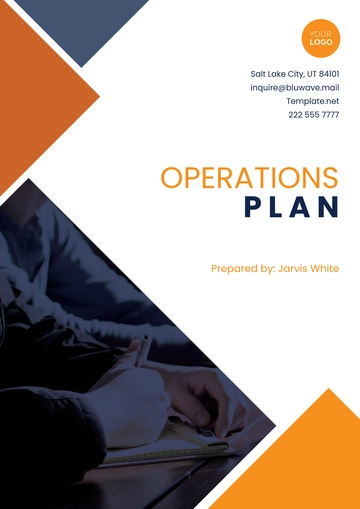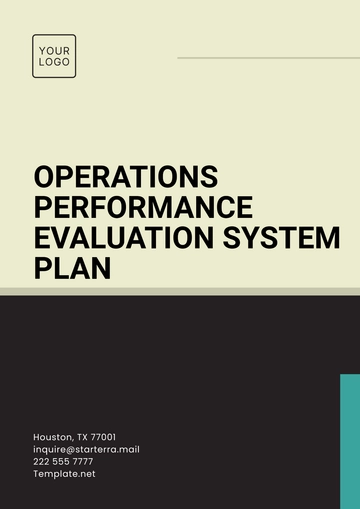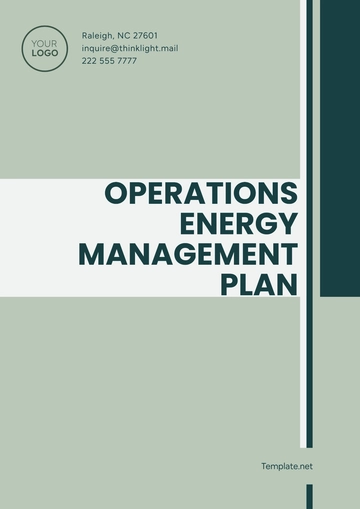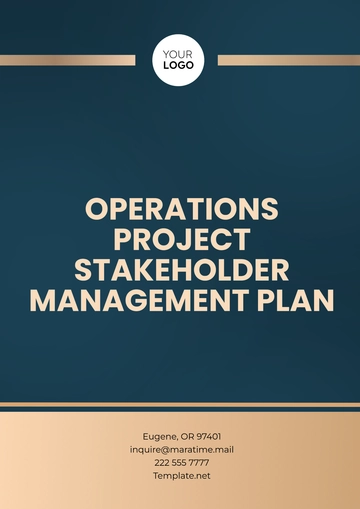Free Mining Logistics Plan

I. Executive Summary
A. Overview of the Mining Logistics Plan
The Mining Logistics Plan for [Your Company Name] outlines the strategic approach for managing the flow of materials, equipment, and resources essential for our mining operations in 2050. It provides a detailed framework for transportation, storage, and supply chain management, ensuring efficient and cost-effective operations. The plan is designed to minimize downtime and risks while maximizing the productivity of mining activities.
B. Objectives and Scope of the Plan
The primary objectives of this plan are to optimize logistics operations, reduce transportation costs, and ensure timely delivery of materials to and from the mining site. This plan covers the procurement, transportation, warehousing, and distribution of raw materials, equipment, and supplies across all mining locations. The scope includes both domestic and international logistics, with a focus on sustainability and compliance with modern environmental regulations.
C. Key Performance Indicators (KPIs) for Logistics Operations
Key metrics for evaluating the success of the logistics plan include on-time delivery rates, transportation cost per ton, and inventory turnover rates. Regular performance reviews will be conducted to assess the effectiveness of the plan in achieving its objectives. A continuous feedback loop will be implemented to identify areas for improvement and ensure that KPIs align with [Your Company Name]'s long-term goals.
D. High-level Summary of Logistics Challenges and Solutions
Logistical challenges include unpredictable weather patterns, supply chain disruptions, and transportation bottlenecks. [Your Company Name] has identified innovative solutions such as automated transport systems, alternative transport routes, and AI-driven predictive maintenance to mitigate these challenges. Additionally, establishing strategic partnerships with key suppliers and third-party logistics providers will further enhance resilience and operational efficiency.
II. Introduction
A. Background of the Mining Operation
[Your Company Name] has been a key player in the global mining industry for over five decades, specializing in the extraction of valuable minerals used in the green energy sector. Our operations are spread across multiple continents, including North America, Africa, and South America, with advanced technologies in place for resource extraction. The company’s commitment to sustainability and innovation has driven the adoption of cutting-edge logistics strategies to support efficient operations.
B. Purpose of the Logistics Plan
The purpose of this logistics plan is to ensure the smooth movement of materials, equipment, and supplies, enhancing operational efficiency while adhering to safety and environmental standards. It is designed to streamline coordination between mining operations, transport providers, and warehouses. Additionally, this plan will enable [Your Company Name] to meet the increasing demand for materials in the evolving green energy market.
C. Stakeholders and Key Personnel Involved
Key stakeholders include the executive management team, logistics coordinators, procurement managers, and external transport and warehouse partners. The logistics department will collaborate with other departments such as safety, procurement, and IT to ensure that the logistics plan aligns with operational needs. Stakeholder engagement will be essential for successful plan execution and long-term sustainability.
D. Key Assumptions and Constraints
This plan assumes the availability of sufficient financial resources, the stability of international trade routes, and the continued availability of skilled labor. Constraints include the potential impact of climate change on transportation and material availability. Furthermore, technological advancements may require periodic updates to ensure that the logistics plan remains relevant in 2050 and beyond.
III. Supply Chain Management
A. Procurement of Materials and Equipment
Procurement processes will be focused on ensuring the timely acquisition of essential materials and mining equipment. [Your Company Name] will maintain long-term contracts with reliable suppliers to mitigate the risk of supply chain disruptions. Additionally, global sourcing strategies will be employed to optimize cost-efficiency and reduce lead times.
B. Sourcing and Transportation of Supplies
The logistics plan incorporates sourcing strategies to ensure that key supplies, such as fuel, explosives, and lubricants, are readily available. We will use a combination of local suppliers for routine materials and international suppliers for specialized products. Transportation of supplies will be handled through a mix of air, sea, and road transport, depending on cost and urgency.
C. Warehousing and Storage
On-site storage will be optimized for materials that are critical to day-to-day operations, with a focus on minimizing space while maintaining safety standards. Off-site warehouses in strategic locations will store bulk materials and backup supplies, ensuring a reliable supply chain. Our inventory management system will use AI-powered forecasting to predict and adjust stock levels based on real-time usage data.
Item | Average Monthly Consumption | Lead Time (Days) | Inventory Buffer (Days) |
|---|---|---|---|
Explosives | 50 tons | 10 | 5 |
Lubricants | |||
Spare Parts | |||
Fuel (Diesel) |
IV. Transportation and Distribution
A. Transport Modes and Methods
The transport network will integrate road, rail, and maritime shipping to ensure the efficient movement of materials. Advanced autonomous vehicles will be deployed for internal transportation on-site, reducing human error and increasing speed. Rail transport will be the primary method for bulk materials, particularly ore, due to its cost-effectiveness and scalability.
B. Transportation Planning
Transportation schedules will be optimized through a centralized system that allows real-time tracking and route optimization. Fleet management software will monitor fuel consumption, maintenance schedules, and route performance. Special attention will be given to high-priority shipments, such as critical equipment or spare parts, which require expedited transport.
C. Delivery and Dispatch
Coordination between the mining sites, warehouses, and distribution centers will be key to maintaining a consistent supply chain. The delivery system will be supported by advanced tracking systems that allow stakeholders to monitor progress and anticipate delays. A dedicated dispatch team will be responsible for coordinating the efficient loading, unloading, and routing of materials.
V. Operational Logistics
A. Material Flow and Movement
Materials will be moved from the extraction point to processing facilities using a combination of conveyor belts and automated trucks. A dedicated system will track material quantities in real-time, ensuring that the flow aligns with production schedules. Waste materials will be transported to designated disposal sites, with an emphasis on reducing environmental impact.
B. Equipment and Machinery Management
Mining equipment will be deployed based on a strict maintenance schedule to ensure optimal performance. Logistics teams will track equipment usage, downtime, and maintenance needs to minimize disruptions. Mobile units will handle equipment transportation to and from mining locations, with specialized vehicles for heavy machinery.
C. Site-specific Logistics Considerations
Each mining site will have a unique set of logistics requirements based on its location and terrain. [Your Company Name] will leverage advanced surveying tools to map out the best transport routes and identify potential bottlenecks. Remote site logistics will also rely on air transport for essential supplies when road access is limited.
VI. Risk Management
A. Identification of Potential Risks
Risks include transportation delays due to adverse weather conditions, supply chain disruptions, and breakdowns of critical equipment. Cybersecurity threats to logistics software are also considered a potential risk. Finally, labor shortages could impact the ability to execute logistics operations efficiently.
B. Risk Mitigation Strategies
To mitigate transportation delays, we will establish multiple transport routes, ensuring flexibility during adverse weather conditions. We will implement predictive maintenance technology to reduce equipment downtime and extend the life of critical machinery. Diversifying suppliers and establishing regional warehouses will reduce supply chain dependency on a single source.
C. Contingency Planning
In the event of transportation disruptions, alternative routes and backup suppliers will be identified and communicated to logistics teams. Emergency response plans will include pre-designated sites for staging equipment and supplies in case of natural disasters. Critical personnel will be trained in logistics recovery procedures to minimize downtime and operational impact.
VII. Compliance and Safety
A. Regulatory Requirements
In 2050, [Your Company Name] will adhere to a global framework of environmental and safety regulations, including the Paris Agreement on Climate Change and international mining safety standards. Compliance will also extend to local environmental and transportation regulations, including emissions limits, waste disposal practices, and handling of hazardous materials. The logistics team will ensure that all activities comply with the evolving legal landscape in each operating region.
B. Safety Protocols and Procedures
All logistics personnel will be trained in handling hazardous materials, including explosive substances and chemicals used in mining operations. Safety measures will include proper personal protective equipment (PPE), emergency response drills, and protocols for high-risk activities, such as transportation of hazardous materials. Each vehicle and piece of equipment will undergo regular safety checks to meet the standards set by regulatory bodies.
C. Employee Training and Awareness Programs
[Your Company Name] will implement ongoing safety and logistics training programs to ensure all employees are well-prepared for emergency situations. New technologies, such as autonomous transport systems, will require specialized training for operators. The company will also promote a culture of safety awareness through regular safety audits and drills.
Training Program | Frequency | Key Topics Covered | Completion Rate (%) |
|---|---|---|---|
Hazardous Materials | Quarterly | Handling, Storage, Emergency Procedures | 95% |
Vehicle Safety Training | Bi-Annually | Vehicle Inspections, Safe Driving Practices | 98% |
Emergency Response | Annually | Fire Safety, Spill Response, First Aid | 92% |
VIII. Technology Integration
A. Logistics Management Systems
[Your Company Name] will integrate a state-of-the-art logistics management system (LMS) powered by artificial intelligence (AI) and machine learning. This system will track materials in real-time, monitor transport conditions, and predict potential delays based on historical data and weather patterns. Advanced analytics will allow logistics managers to optimize the supply chain and reduce costs by identifying inefficiencies.
B. Automation and Innovation
Autonomous trucks and drones will be deployed for the transportation of both materials and personnel within mining sites. These technologies will reduce human error, increase transport speeds, and improve safety. Additionally, AI-driven predictive maintenance will be used to monitor equipment health and prevent unscheduled downtime, helping to improve operational efficiency.
C. Communication Systems and Real-time Monitoring
Communication between mining sites, warehouses, and logistics teams will be facilitated by a secure, integrated platform that provides real-time updates on inventory levels, equipment status, and delivery schedules. Satellite communication systems will be used to ensure connectivity in remote areas. Mobile applications will be provided to drivers and warehouse personnel for instant updates on orders, routing, and schedules.
Technology | Deployment Timeline | Key Features | Expected Impact |
|---|---|---|---|
Autonomous Trucks | Q3 2051 | Self-driving, Route optimization, Real-time monitoring | 20% reduction in transportation costs |
AI Maintenance System | Q1 2050 | Predictive analytics, Equipment health monitoring | 15% reduction in equipment downtime |
Integrated LMS | Q2 2050 | Real-time tracking, Supply chain optimization | 25% improvement in on-time deliveries |
IX. Cost Analysis and Budgeting
A. Estimated Costs for Transportation, Storage, and Supply
The logistics costs will include transportation expenses (fuel, shipping), storage costs (warehouse rentals, on-site storage), and supply procurement costs. In 2050, due to the implementation of automated transport systems and advanced tracking, transportation costs are projected to decrease by 15%. The company will also see cost savings from optimized inventory management and reduced waste.
B. Budget Allocation and Resource Management
The budget will allocate funds for infrastructure improvements, technology investments, and workforce training. A significant portion of the budget will be directed toward the development and deployment of autonomous vehicles and advanced logistics management systems. The allocation of resources will be reviewed annually to ensure that funds are effectively distributed and operations remain cost-effective.
C. Cost Reduction Strategies and Efficiency Improvements
Cost reduction will be achieved through the implementation of more efficient transportation routes, reductions in warehouse space through better inventory management, and the automation of manual logistics processes. Real-time data analytics will enable better decision-making, leading to lower fuel consumption and faster transportation.
Category | Estimated Cost (USD) | 2050 Projected Budget (USD) | Cost Reduction (%) |
|---|---|---|---|
Transportation | $50 million | $42 million | 15% |
Warehousing & Storage | |||
Supply Procurement | |||
Technology Integration |
X. Performance Monitoring and Reporting
A. KPIs for Logistics Performance
Key Performance Indicators (KPIs) for logistics include:
On-time delivery rate: Target is 95% or higher for all shipments.
Transportation cost per ton: Maintain a reduction in cost per ton by at least 15% annually.
Inventory turnover: Achieve a 10% increase in inventory turnover every year.
B. Reporting Systems and Frequency
The logistics team will provide detailed monthly reports covering key metrics such as transportation costs, on-time delivery rates, and inventory status. Real-time performance monitoring will also be available through a centralized dashboard. Reports will be delivered to senior management, and operational adjustments will be made based on findings.
C. Continuous Improvement and Feedback Mechanisms
Continuous improvement will be driven by employee feedback, customer satisfaction surveys, and performance reviews. Feedback from the field, such as driver and warehouse worker insights, will be used to refine processes and identify areas for optimization. Regular audits will ensure that processes remain aligned with best practices.
KPI | Target Value | Actual (2050) |
|---|---|---|
On-Time Delivery Rate | 95% | 98% |
Transportation Cost/Ton | ||
Inventory Turnover |
XI. Conclusion
A. Summary of the Mining Logistics Plan
The Mining Logistics Plan for [Your Company Name] is a comprehensive strategy that integrates advanced technologies and logistics best practices to ensure smooth operations across all mining sites. By optimizing transportation, storage, and supply chain management, we aim to reduce costs, improve efficiency, and maintain a high level of safety and compliance.
B. Final Recommendations for Improving Logistics Efficiency
It is recommended that [Your Company Name] continue investing in automation technologies and AI-driven tools to further streamline logistics operations. Additionally, further collaboration with external logistics partners will be essential to manage peak demand and address unforeseen disruptions effectively.
C. Next Steps and Implementation Timeline
The next steps involve finalizing the logistics software implementation by Q2 2050, followed by the rollout of autonomous transport systems by Q3 2051. Additionally, training programs for staff will begin immediately to ensure all teams are equipped to manage the new technologies.
- 100% Customizable, free editor
- Access 1 Million+ Templates, photo’s & graphics
- Download or share as a template
- Click and replace photos, graphics, text, backgrounds
- Resize, crop, AI write & more
- Access advanced editor
Efficiently manage your mining logistics with the Mining Logistics Plan Template from Template.net. Fully editable and customizable, this template allows you to tailor each section to your specific needs, ensuring a streamlined workflow. Enhance your planning process with the integrated AI Editor Tool, designed to simplify and optimize your logistics operations for maximum efficiency.
You may also like
- Finance Plan
- Construction Plan
- Sales Plan
- Development Plan
- Career Plan
- Budget Plan
- HR Plan
- Education Plan
- Transition Plan
- Work Plan
- Training Plan
- Communication Plan
- Operation Plan
- Health And Safety Plan
- Strategy Plan
- Professional Development Plan
- Advertising Plan
- Risk Management Plan
- Restaurant Plan
- School Plan
- Nursing Home Patient Care Plan
- Nursing Care Plan
- Plan Event
- Startup Plan
- Social Media Plan
- Staffing Plan
- Annual Plan
- Content Plan
- Payment Plan
- Implementation Plan
- Hotel Plan
- Workout Plan
- Accounting Plan
- Campaign Plan
- Essay Plan
- 30 60 90 Day Plan
- Research Plan
- Recruitment Plan
- 90 Day Plan
- Quarterly Plan
- Emergency Plan
- 5 Year Plan
- Gym Plan
- Personal Plan
- IT and Software Plan
- Treatment Plan
- Real Estate Plan
- Law Firm Plan
- Healthcare Plan
- Improvement Plan
- Media Plan
- 5 Year Business Plan
- Learning Plan
- Marketing Campaign Plan
- Travel Agency Plan
- Cleaning Services Plan
- Interior Design Plan
- Performance Plan
- PR Plan
- Birth Plan
- Life Plan
- SEO Plan
- Disaster Recovery Plan
- Continuity Plan
- Launch Plan
- Legal Plan
- Behavior Plan
- Performance Improvement Plan
- Salon Plan
- Security Plan
- Security Management Plan
- Employee Development Plan
- Quality Plan
- Service Improvement Plan
- Growth Plan
- Incident Response Plan
- Basketball Plan
- Emergency Action Plan
- Product Launch Plan
- Spa Plan
- Employee Training Plan
- Data Analysis Plan
- Employee Action Plan
- Territory Plan
- Audit Plan
- Classroom Plan
- Activity Plan
- Parenting Plan
- Care Plan
- Project Execution Plan
- Exercise Plan
- Internship Plan
- Software Development Plan
- Continuous Improvement Plan
- Leave Plan
- 90 Day Sales Plan
- Advertising Agency Plan
- Employee Transition Plan
- Smart Action Plan
- Workplace Safety Plan
- Behavior Change Plan
- Contingency Plan
- Continuity of Operations Plan
- Health Plan
- Quality Control Plan
- Self Plan
- Sports Development Plan
- Change Management Plan
- Ecommerce Plan
- Personal Financial Plan
- Process Improvement Plan
- 30-60-90 Day Sales Plan
- Crisis Management Plan
- Engagement Plan
- Execution Plan
- Pandemic Plan
- Quality Assurance Plan
- Service Continuity Plan
- Agile Project Plan
- Fundraising Plan
- Job Transition Plan
- Asset Maintenance Plan
- Maintenance Plan
- Software Test Plan
- Staff Training and Development Plan
- 3 Year Plan
- Brand Activation Plan
- Release Plan
- Resource Plan
- Risk Mitigation Plan
- Teacher Plan
- 30 60 90 Day Plan for New Manager
- Food Safety Plan
- Food Truck Plan
- Hiring Plan
- Quality Management Plan
- Wellness Plan
- Behavior Intervention Plan
- Bonus Plan
- Investment Plan
- Maternity Leave Plan
- Pandemic Response Plan
- Succession Planning
- Coaching Plan
- Configuration Management Plan
- Remote Work Plan
- Self Care Plan
- Teaching Plan
- 100-Day Plan
- HACCP Plan
- Student Plan
- Sustainability Plan
- 30 60 90 Day Plan for Interview
- Access Plan
- Site Specific Safety Plan





























